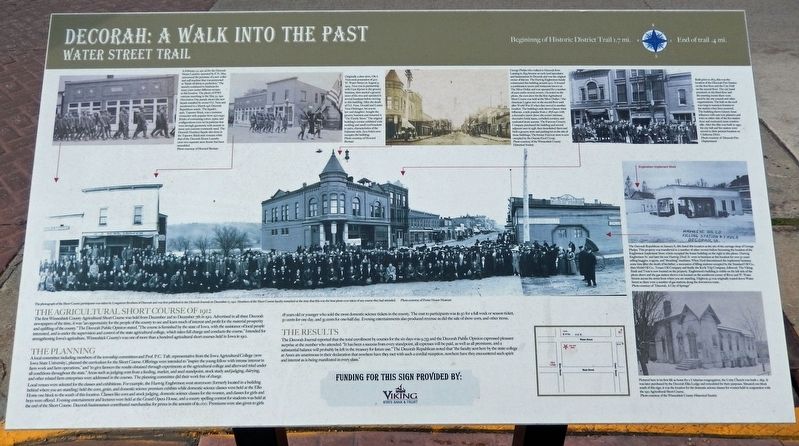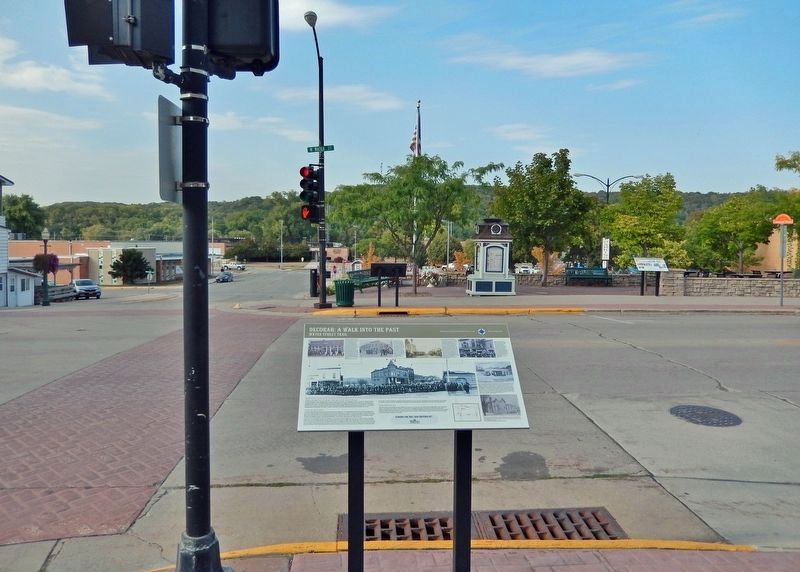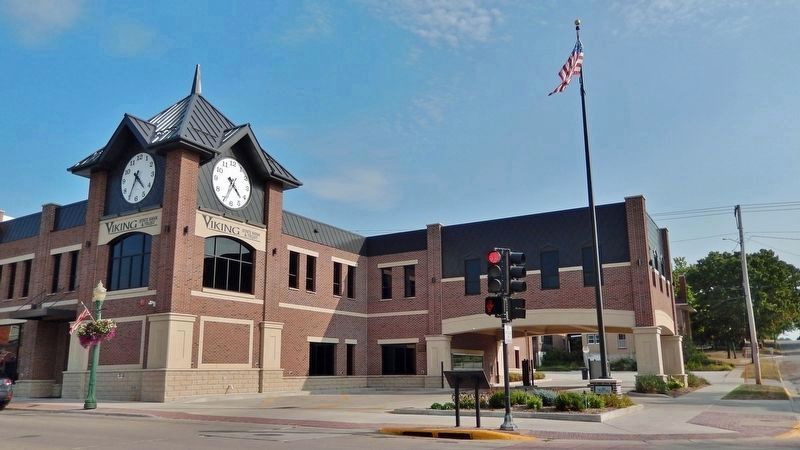Decorah in Winneshiek County, Iowa — The American Midwest (Upper Plains)
Decorah: A Walk into the Past
Water Street Trail
The Agricultural Short Course of 1912
The first Winneshiek County Agricultural Short Course was held from December 2nd to December 7th in 1912. Advertised in all three Decorah newspapers of the time, it was “an opportunity for the people of the county to see and learn much of interest and profit for the material prosperity and uplifting of the county.” The Decorah Public Opinion stated, “The course is furnished by the state of Iowa, with the assistance of local people interested, and is under the supervision and control of the state agricultural college, which takes full charge and conducts the course.” Intended for strengthening Iowa's agriculture, Winneshiek County's was one of more than a hundred agricultural short courses held in Iowa in 1912.
The Planning
A local committee including members of the township committees and Prof. P.C. Taft, representative from the Iowa Agricultural college (now Iowa State University), planned the curriculum for the Short Course. Offerings were intended to “inspire the young fellow with intense interest in farm work and farm operations,” and “to give farmers the results obtained through experiments at the agricultural college and afterward tried under all conditions throughout the state.” Areas such as judging corn from a feeding, market, and seed standpoint, stock study and judging, dairying, and other related farm enterprises were addressed in the courses. The planning committee did their work free of charge.
Local venues were selected for the classes and exhibitions. For example, the Hartvig Engbretson west storeroom (formerly located in a building behind where you are standing) held the corn, grain, and domestic science premium exhibits while domestic science classes were held at the Elks Home one block to the south of this location. Classes like corn and stock judging, domestic science classes for the women, and classes for girls and boys were offered. Evening entertainment and lectures were held at the Grand Opera House, and a county spelling contest for students was held at the end of the Short Course. Decorah businessmen contributed merchandise for prizes in the amount of $1,000. Premiums were also given to girls 18 years old or younger who sold the most domestic science tickets in the county. The cost to participants was $1.50 for a full week or season ticket, 50 cents for one day, and 35 cents for one-half day. Evening entertainments also produced revenue as did the sale of show corn, and other items.
The Results
The Decorah Journal reported that the total enrollment by courses for the six days was 9,753 and the Decorah Public Opinion expressed pleasant surprise at the number
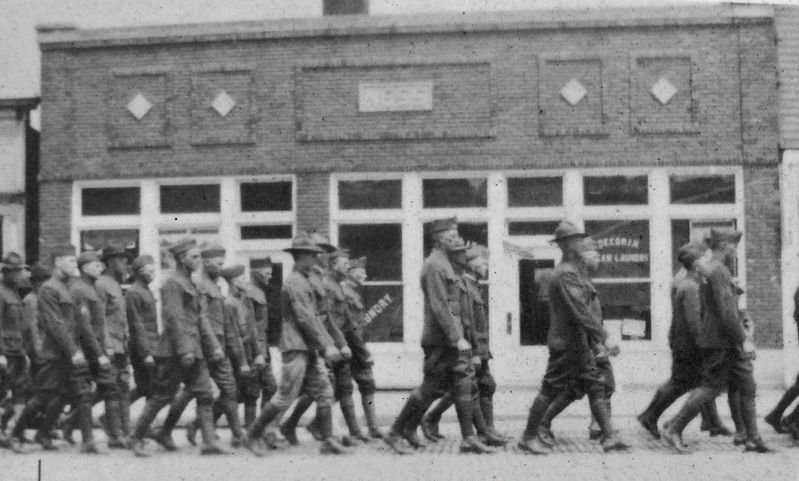
Courtesy Howard Bernatz
2. Marker detail: February 22, 1911 ad for the Decorah Steam Laundry
A February 22, 1911 ad for the Decorah Steam Laundry operated by F.N. May announced the purchase of a new collar and cuff machine that was purported to “finish off shirts to perfection.” The laundry continued in business for many years under different owners at this location. The photo of WWI veterans marching in the May 30, 1921 Decoration Day parade shows the new façade installed by owner O.J. Ness and mentioned in a March 1916 Decorah Republican article. The façade’s style, Tapestry Brick, was a common vernacular style popular from 1900-1930. Bricks of contrasting colors, types, and configurations were set in patterns that were strongly geometric with accents in stone and concrete commonly used. The Decorah Hatchery façade also done in the Tapestry Brick style remains while that of the Decorah Steam Laundry (now two separate store fronts) has been remodeled.
Funding for this sign provided by Viking State Bank & Trust
Topics. This historical marker is listed in these topic lists: Agriculture • Architecture • Education • Industry & Commerce. A significant historical date for this entry is December 2, 1912.
Location. 43° 18.246′ N, 91° 47.371′ W. Marker is in Decorah, Iowa, in Winneshiek County. Marker is at the intersection of West Water Street and River Street, on the left when traveling west on West Water Street. The marker is located along the sidewalk at the southeast corner of the intersection. Touch for map. Marker is at or near this postal address: 321 West Water Street, Decorah IA 52101, United States of America. Touch for directions.
Other nearby markers. At least 8 other markers are within walking distance of this marker. A different marker also named Decorah: A Walk into the Past (a few steps from this marker); a different marker also named Decorah: A Walk into the Past (a few steps from this marker); a different marker
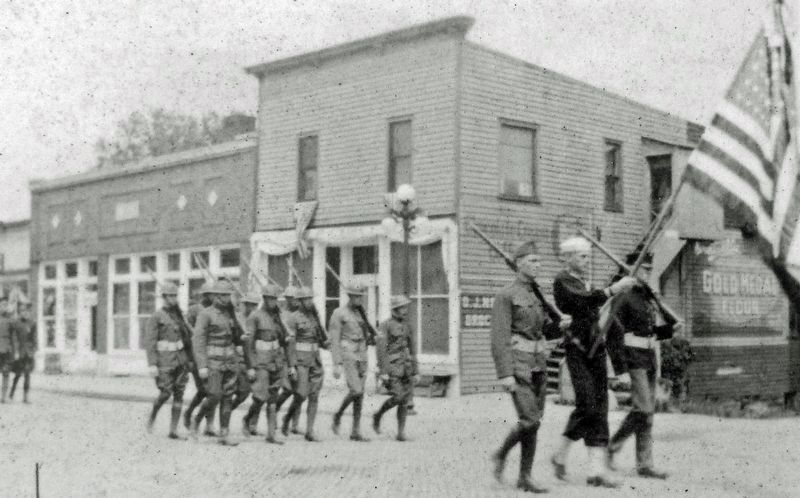
Courtesy Howard Bernatz
3. Marker detail: 400 West Water Street
Originally a shoe store, Ole J. Ness took possession of 400 W. Water Street on August 9, 1909. Ness was in partnership with Gust Kjome in the grocery business, then started a grocery store of his own and operated in several locations before moving to this building. After the death of O.J. Ness, Donald and Louise Ness Flickinger, his son-in-law and daughter, bought the grocery business and renamed it “The Family Store.” The original building's cornice exhibited wide molding and small roof brackets in pairs, characteristics of the Italianate style. Java John's now occupies the building.
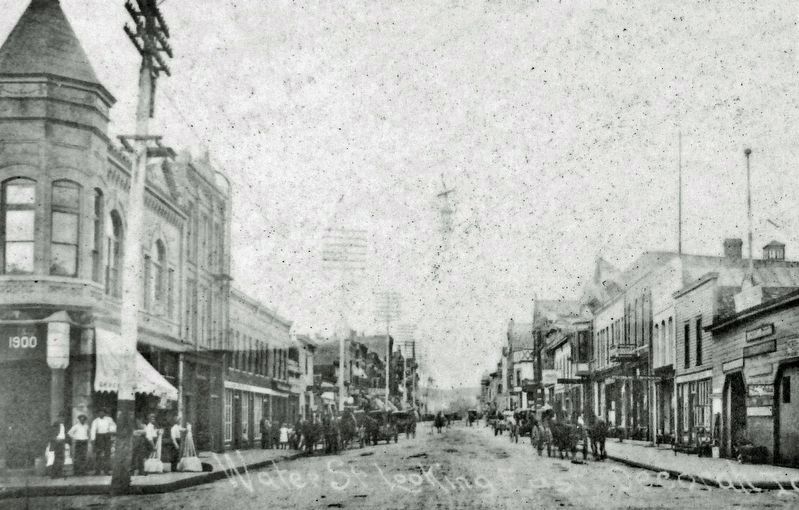
Winneshiek County Historical Society
4. Marker detail: George Phelps / The Silver Dollar
George Phelps who walked to Decorah from Lansing in 1854 became an early land speculator and businessman in Decorah and was the original owner of this lot. The Hartvig Engbretson family constructed this building around 1900. It housed a combination tavern and restaurant known as The Silver Dollar and was operated for a number of years under several owners. (As noted on the photo, the corn show for the first Agricultural Short Course was held at the Silver Dollar.) The American Legion met on the second floor until after World War II when they moved to another location. The building’s style shows Queen Anne influence, a style popular from c.1876-1910 with a decorative turret above the corner entrance, decorative brick insets, corbelled cornices, and rusticated stone accents. The Fareway Grocery Company purchased the building and several adjacent ones in 1958, then demolished them and built a grocery store and parking lot on the site of those buildings. The former Fareway store is now occupied by the Oneota Food Co-op.
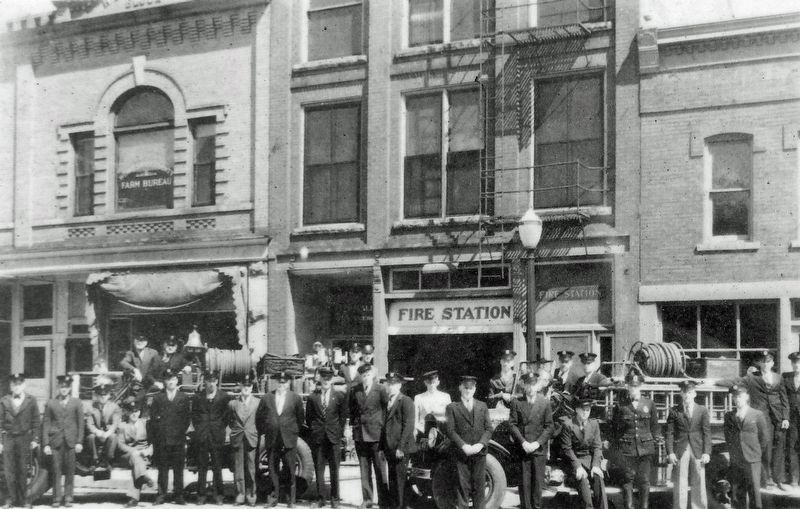
Courtesy Decorah Fire Department
5. Marker detail: The Decorah Fire Station & City Hall
Built prior to 1873, this was the location of the Decorah Fire Station on the first floor and the City Hall on the second floor. The city band practiced on the third floor and the meeting rooms there were used by the city council and other organizations. The bell on the roof was rung to summon firemen to the station when fires occurred. The building shows Queen Anne influence with cast iron pilasters and trim on either side of the fire station door and rusticated stone window sills. After the dike was built in 1950, the city hall and fire station were moved to their present location on Claiborne Drive.
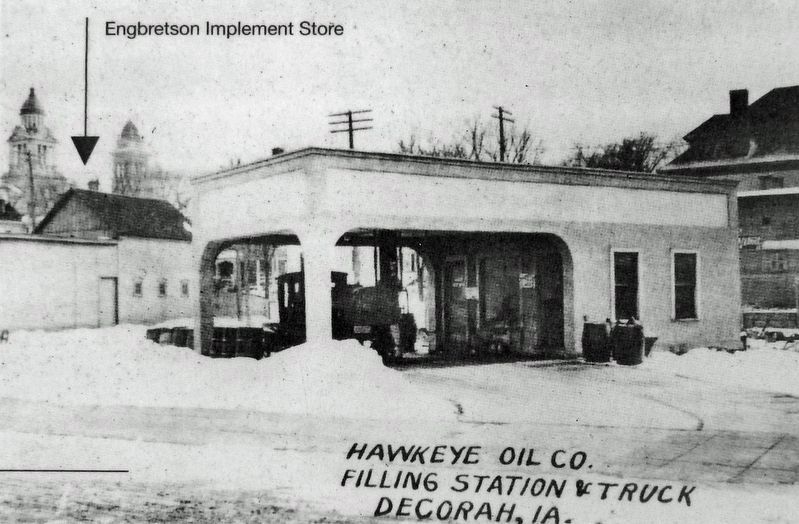
Courtesy “Decorah, A City of Springs”
6. Marker detail: Hawkeye Oil Company
The Decorah Republican on January 8, 1861 listed this location as the site of the carriage shop of George Phelps. This property was transferred to a number of other owners before becoming the location of the Engbretson Implement Store which occupied the frame building on the right in this photo. Hartvig Engbretson Sr. and later his son Hartvig (Hod) Jr. were in business at this location for over 50 years selling buggies, wagons, and “thrashing” machines. When Hod discontinued the implement business sometime after the death of his father, a succession of filling stations occupied by the Standard Oil Co., then Mobil Oil Co., Texaco Oil Company and finally the Kwik Trip Company, followed. The Viking Bank and Trust is now located on the property. Engbretson's building is visible on the left side of the photo above and the gas station shown was located on the southwest corner of River and W. Water Streets across the street from where you are standing. Highway 52 was originally routed down Water Street so there were a number of gas stations along the downtown route.
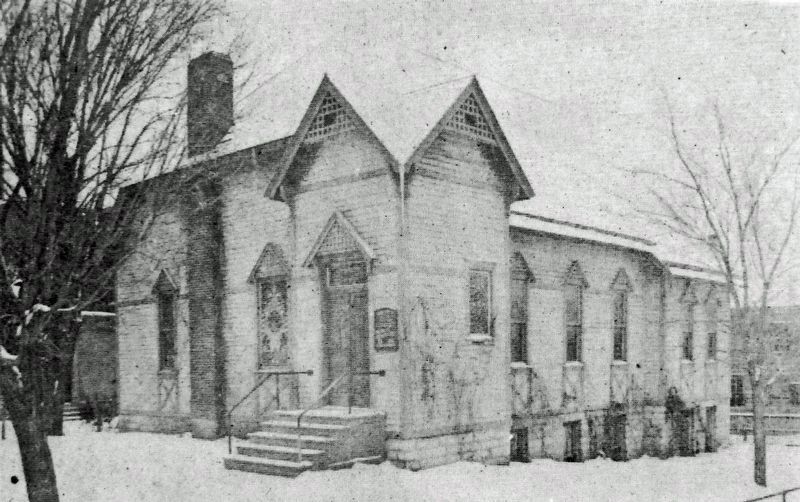
Winneshiek County Historical Society
7. Marker detail: Unity Church, built c. 1891
Pictured here in its first life as home for a Unitarian congregation, the Unity Church was built c. 1891. It was later purchased by the Decorah Elks Lodge and remodeled for their purposes. Situated one block south of this sign, it was the location for the domestic science classes for women held in conjunction with the 1912 Agricultural Short Course.

Courtesy Porter House Museum, 1912
8. Marker detail: Short Course Participants
The photograph of the Short Course participants was taken by Longstreet Brothers of Decorah and was first published in the Decorah Journal on December 17, 1912. Members of the Short Course faculty remarked at the time that this was the best photo ever taken of any course they had attended.
Credits. This page was last revised on February 20, 2024. It was originally submitted on February 19, 2024, by Cosmos Mariner of Cape Canaveral, Florida. This page has been viewed 64 times since then. Photos: 1, 2, 3, 4, 5, 6, 7, 8, 9, 10. submitted on February 20, 2024, by Cosmos Mariner of Cape Canaveral, Florida.
